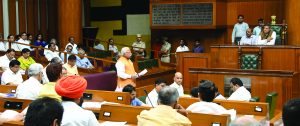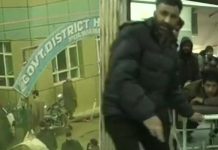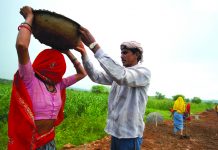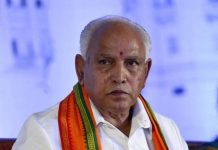 The General Elections of 2019 have set the tone for the assembly elections in Haryana. The political parties are geared up to jump the election bandwagon shortly after the results of Lok Sabha Polls. Haryana went to polls on 12th of May for the crucial fight. Haryana sends 10 Members of the Parliament to the Lok Sabha and 90 Members of the Legislative Assembly to the Vidhan Sabha. The last assembly elections in the state were held on 15the October 2014 and the results were announced on 19 October, 2014. So the elections are expected sooner than later and the stakes are high for all the parties.
The General Elections of 2019 have set the tone for the assembly elections in Haryana. The political parties are geared up to jump the election bandwagon shortly after the results of Lok Sabha Polls. Haryana went to polls on 12th of May for the crucial fight. Haryana sends 10 Members of the Parliament to the Lok Sabha and 90 Members of the Legislative Assembly to the Vidhan Sabha. The last assembly elections in the state were held on 15the October 2014 and the results were announced on 19 October, 2014. So the elections are expected sooner than later and the stakes are high for all the parties.
During the last assembly elections, the Bharatiya Janta Party surprised everybody by winning 47 seats in Haryana, gaining a clear majority. Indian National Lokdal, a regional outfit, had to eat a humble pie with 19 seats and was ranked second. After ruling for two successive terms under Bhupinder Singh Hooda and facing a strong anti-incumbency at the Centre in 2014 General Elections, Congress repeated its poor show in Haryana with 15 seats and ranked third. Haryana Janhit Congress (now defunct) won 2 seats. The overwhelming victory of BJP in Haryana for the first time was credited to the Modi wave as there was euphoria over Sabka Saath Sabka Vikas and many other promises to woo the voters.
The initial phase of BJP rule in Haryana was fraught with the reports of heartburn of many stalwarts in state party who were more ambitious and peeved at the selection of Manohar Lal Khattar as the Chief Minister of the state. In February 2016, Haryana hit headlines for Jat community’s agitation for reservation in Government jobs and the total collapse of law and order in the state resulting death of 10 persons. Besides bloodshed, loss of livelihood and property worth millions of rupees during the violent protests incurred the wrath of common public and senior leaders of BJP on Khattar government.
Albeit full majority in the house, Bhartiya Janata Party that ruled for the first time in Haryana could not prepare a good report card of its performance during the five years. Chief Minister Khattar when took charge, had announced a cotton cluster in the cotton growing belt of Haryana spread across the districts of Sirsa and Hisar. It is a long standing demand of the industry as the cotton cultivation in the state has grown by leaps and bound in the past few years but due to better incentives in the neighbouring Rajasthan, the ginning industry has flourished there. Haryana produces 30 lakh bales of cotton every year but consumes only 3 lakh bales. According to Sushil Mittal, President of Haryana Ginning Millers’ Association, the market fee on cotton in Haryana is 2.80 per cent against 1.60 per cent in Rajasthan. At the same time, it is only 0.80 per cent for the new units established for first five years in Rajasthan. Khattar government announced a complete waiver of market fee for five years for new ginning mills. A couple of new ginning mills were put up in Haryana in the wake of this incentive but the notification for that has not come yet. Some of them knocked the door of courts and are now fighting legal battle.
Industry in Haryana is languishing, one due to overall slowdown and second, due to own policies of the state. The slowdown in auto industry has badly hit the business of ancillary units in auto cluster of Gurugram and a slack demand has resulted in job cuts.
The real estate sector that had become a major growth driver in Haryana due to its proximity to National Capital and proposed projects on National Highway 1 also registered retardation in the last few years. Agriculture is already marred with issues like growing cost of inputs (seeds, fertilizers, pesticides, diesel etc), depleting water table and rising debt of farmers.
So the voter in Haryana is not likely to give another chance to the ruling party. “The issues in assembly elections differ from those in Parliamentary elections. Local issues carry too much weight in assembly elections. The result of Lok Sabha election may also cast a shadow on the mood of voters. A government at centre- with or without Modi- can also be a deciding factor”, told a voter.
Unemployment is a very big issue in Haryana and was one of the prime reasons for the Jat agitation. Over the years, the size of the landholdings in the state has shrunk and remuneration in agriculture has not increased in proportion to the investment. The newly formed JJP (Jananayak Janata Party) found by the Chautala scion Dushyant Chautala in December 2018 may touch a chord with the young voters in some parts of Haryana. The Congress Spokesperson Randeep Surjewala is also seen as a young face to reach out the voters.
In Haryana, the caste equations matter a lot. There are some Jat dominated areas especially the districts of Rohtak, Jind, Bhiwani and Sonepat. Whereas Gurgaon and Faridabad have voters with a mix of caste and cultural backgrounds. Punjabi voters are counted in districts like Karnal, Panchkula and pockets in the vicinity.
The President of Bhartiya Kisan Union Bhupinder Singh Mann told that farmers would wish to vote for those who think in favour of farmers. The incumbent government failed to fulfil promises. A half-hearted implementation of schemes like Crop Insurance, Bhavantar Yojna and many other schemes has eroded the confidence of farmers. The manifesto of Congress that talks of Essential Commodities Act, a separate budget on agriculture to bring transparency and schemes for the marginalised farmers can attract the voters. But more would depend on the skills of the parties on creating communication bridges with the voters. Haryana voter, he said, is straight forward and would welcome the debates on local issues by political parties.
The farmer leader Guni prakash Falgu told that they may sensitise the farmers to press NOTA for ballot in the assembly elections as no political party raised the farmers’ issue in Lok Sabha polls. He added that if their attitude remains the same during assembly poll as well farmers will use NOTA to teach them the importance of poor voters in a democracy. “Few farmers have chose NOTA on 12th May in Haryana and we can sense this matters to the political players. So we may exercise this option in a more organised way to declare the elections null and void if our problems are not addressed to”, he added.
Puneet Singh, a progressive farmer from Ambala, told that the Lok Sabha Elections were like a dress rehearsal for the political parties. The brigade of MLAs (Members of Legislative Assemblies), that approached the voters for candidates for Lok Sabha, simultaneously solicited votes for the upcoming assembly elections. The ruling party in Haryana may capitalize the few weeks from model code of conduct to announce projects and gather publicity. Social media has also played a crucial role even in the hinterland and helped shape the minds of voters.
The successive governments have failed to rationally exploit the natural endowments and entrepreneurial skills of people of Haryana. Haryanavis have done the nation proud by sending their boys in defence services and excelling in international sports. In the forthcoming elections, the wit and valour of the people this state could be a challenge for the political contenders who envisage winning only with the help of propaganda.
letters@tehelka.com











